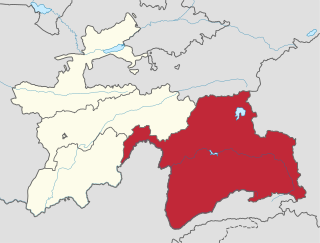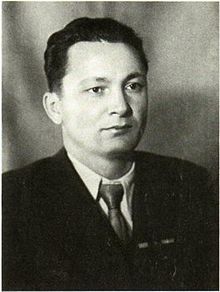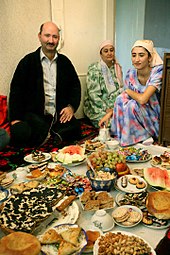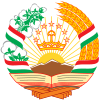
Tajikistan, officially the Republic of Tajikistan, is a landlocked country in Central Asia. Dushanbe is the capital and most populous city. Tajikistan is bordered by Afghanistan to the south, Uzbekistan to the west, Kyrgyzstan to the north, and China to the east. It is separated from Pakistan by Afghanistan's Wakhan Corridor. It has a population of approximately 10.6 million people.

The Demographics of Tajikistan is about the demography of the population of Tajikistan, including population growth, population density, ethnicity, education level, health, economic status, religious affiliations, and other aspects of the population.

Dushanbe is the capital and largest city of Tajikistan. As of March 2024, Dushanbe had a population of 1,564,700, with this population being largely Tajik. Until 1929, the city was known in Russian as Dyushambe, and from 1929 to 1961 as Stalinabad, after Joseph Stalin. Dushanbe is located in the Gissar Valley, bounded by the Gissar Range in the north and east and the Babatag, Aktau, Rangontau and Karatau mountains in the south, and has an elevation of 750–930 m. The city is divided into four districts: Ismail Samani, Avicenna, Ferdowsi, and Shah Mansur.

Tajik, Tajik Persian, Tajiki Persian, also called Tajiki, is the variety of Persian spoken in Tajikistan and Uzbekistan by Tajiks. It is closely related to neighbouring Dari of Afghanistan with which it forms a continuum of mutually intelligible varieties of the Persian language. Several scholars consider Tajik as a dialectal variety of Persian rather than a language on its own. The popularity of this conception of Tajik as a variety of Persian was such that, during the period in which Tajik intellectuals were trying to establish Tajik as a language separate from Persian, prominent intellectual Sadriddin Ayni counterargued that Tajik was not a "bastardised dialect" of Persian. The issue of whether Tajik and Persian are to be considered two dialects of a single language or two discrete languages has political aspects to it.

Gorno-Badakhshan, officially the Badakhshan Mountainous Autonomous Region, is an autonomous region in eastern Tajikistan, in the Pamir Mountains. It makes up nearly forty-five percent of the country's land area but only two percent of its population.

The Tajikistani Civil War, also known as the Tajik Civil War, began in May 1992 and ended in June 1997. Regional groups from the Garm and Gorno-Badakhshan regions of Tajikistan rose up against the newly formed government of President Rahmon Nabiyev, which was dominated by people from the Khujand and Kulob regions. The rebel groups were led by a combination of liberal democratic reformers and Islamists, who would later organize under the banner of the United Tajik Opposition. The government was supported by Russian military and border guards.

The Communist Party of Tajikistan is the oldest political party in Tajikistan. The party was founded on 6 December 1924 and was the ruling party of the Tajik Autonomous Soviet Socialist Republic from 1924 to 1929 and the Tajik Soviet Socialist Republic from 1929 to 1990 as part of the Soviet Union as a republican branch of the Communist Party of the Soviet Union. It was banned in 1991 following the 1991 coup.
CSKA Pamir Dushanbe is a professional football club based in Dushanbe, Tajikistan, that currently plays in the Tajikistan Higher League, the country's top division. Since 1997, the club has been under the patronage of the Tajik Army, like its former rivals CSKA Dushanbe.

The Pamiris are an Eastern Iranian ethnic group, native to Central Asia, living primarily in Tajikistan (Gorno-Badakhshan), Afghanistan (Badakhshan), Pakistan (Gilgit-Baltistan) and China. They speak a variety of different languages, amongst which languages of the Eastern Iranian Pamir language group stand out. The languages of the Shughni-Rushani group, alongside Wakhi, are the most widely spoken Pamiri languages.

Tajik cuisine is a traditional cuisine of Tajikistan, and has much in common with Iranian, Afghan, Russian, Chinese, and Uzbek cuisines. Palov or palav (pilaf), also called osh, is the national dish in Tajikistan, as in other countries in the region. Green tea is the national drink.
In parallel to what happened in other Soviet republics, a cinema of Tajikistan was promoted by the Soviet state, and declined in the first years after the independence, before being revitalized through the efforts of the new government.

Islam is the predominant religion in Tajikistan.

The following outline is provided as an overview of and topical guide to Tajikistan:

The insurgency in the Gorno-Badakhshan region in Tajikistan from 2010 to 2015 was an armed conflict between the Tajik Army and Islamist militants, led by numerous leaders from the Tajikistani Civil War. The conflict evolved in 2010 and climaxed in 2012, with the defeat of main rebel forces. Other incidents took place in September 2015, when former deputy defense minister Abduhalim Nazarzoda led an armed uprising, suspected of ties to the Islamic Renaissance Party.

Mirsaid Mirshakar or Mirsaid Mirshakarov was a Soviet and Tajikistani poet, writer, dramatist and editor. A representative of the Supreme Council of the SSR of Tajikistan, a member of the Central Committee of the Republic of Tajikistan, the chairman of the Republican Committee of Sympathy with Asian and African Countries, a member of the Presidium of the Soviet Committee of Sympathy with Asian and African Countries, a member of the board of the Union of Writers of Tajikistan.
Nigina Raufova was a Tajikistani singer and composer, active beginning in the Soviet era.
Jonon Karimovna Bobokalonova was a Tajikistani writer, literary critic, and academic of the Soviet era. Her name is sometimes given as Jonon Karim.
Nuqra Rahmatova was a Tajikistani folk singer and dancer of the Soviet era.

The Ismaili Centre, Dushanbe, is one of six Ismaili Centres worldwide and an Ismaili jamatkhana. It was the fifth purpose-built Ismaili Centre, and the first in Central Asia.
Yuri Filimonovich Ponosov was a Tajikistani of Russian descent who was a Soviet politician.




















